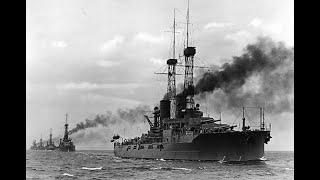
The Development of US Navy Tactics (1895-1939) - From Small Beginnings...
Комментарии:

Pinned post for Q&A :)
Ответить
Bald Damon Hill
Ответить
Sailors love their coscouse.
Ответить
It's extremely important to remember that even before this time line the United States Navy was a baby. Most of their experience was in basic Navy gorilla warfare. Involving blockade running in small scale naval conflicts around their own home turf. Even in the large scale civil war the doctrine or tactics of the time for what was needed was completely different than how it would be anywhere else. Take the Taliban who are experts at fighting in their own arena but put them in the jungle and see how they do. So in the timeline for this video discusses the United States naval doctrine was very young and specifically tailored only against what experiences they had. Large scale coordinated naval movements was not in their vocabulary.
Ответить
Hmmm .. learning in WW2..... I think the biggest learning curve was to stop putting old idiots in charge of cruiser/destroyer fleets that engage enemy cruiser/destroyer fleets....at night ... Those admirals at the Salomon Island campaigns were as bad or equal of those responsible for both Pearl Harbor and the Philippines on 12/7/41 ...just saying those naval leaders were completely responsible for losing Battle of Sabo Island to name one... We learned never to repeat that battle again.
That admiral should have gone down without the ship he got sunk in ..the captains of the destroyers and cruisers wanted to fire first but he had a bug up his butt about radar ..his early warning system
Why even have it if your too old to embrace new technology

I think it would have better worked if you added some animations...
Ответить
Great guest, thanks!!!
Ответить
We love you, your prodigal sons fore ever the USA.
Ответить
Really learned a lot from this series! Amazing!
Ответить
Top rate content. This guest was more articulate than most.
Ответить
Drachinifel, at some point, you NEED to consider playing Rule the Waves 2. With your knowledge of 18th century naval history and development, you would enjoy it!
Ответить
more graphics/pictures/diagrams..............
Ответить
It's interesting how many influential books on naval topics recently have been written by amateurs. There was Miller, Parshall and Tully, and others I can't think of right now, and now Hone.
Ответить
What was the effect of the USN battleship division's experience with the Grand Fleet in WWi on USN tactics & doctrine post war?
Ответить
I really hope this books winds up on audible, I'll get through it much faster if I can listen to it while commuting.
Ответить
Oh dam son this is awesome! I am a history geek and your channel is awesome, sir!
Ответить
Dam son I am geeking out already! I am a history buff and thoroughly enjoy what you bring to the table. outstanding!
Ответить
Platforms matter back then and most definitely today also!
Ответить
These are nice, but less concise and directional, it almost would've been better if he made these as base videos himself, and then recorded interviews as a supporting gimmick.
Ответить
Despite the United States Navy (USN) doing more sophisiticated fleet and night action engagements training in the 1920s and 1930s, their early actions in the Pacfic War (in this regard) were less than successful. Not only in the Battle of the Java Sea, but later in the Battle of the Coral Sea (even though this was a USN strategic win, thank god). Both carrier fleets steamed past one another repeatedly (in plane attack range), while over the horizon admittedly (showing the mistakes of both navies in the early era of plane scouting, but the US ships had early radar, which the Imperial Japanese Navy (IJN), did not). Futhermore, at the Battle of Tasserfaronga, this was a significant tactical victory to the IJN during a night time action where the USN (and allied fleet ships) performed poorly. Again, radar by the USN was an unused advantage. It was not until 1943, aided stongly by continual air superiority strengthening and improving radar operation for individial ships and fleets, that the USN (and it's allies) were asserting naval dominance in the Western Pacific.
Ответить
Very good, thank you.
Ответить
I feel like double stacked Oreo four gunned turrets (such as the early uss New Jersey and the lot) should have deserved an explanation.
Ответить
Trent comment on the US introducing a range keeper in 1916 makes me want a video with a in depth dive into central fire control development of the major powers from like 1900 to 1945 including radar guided gunnery and how they compare in performance.
It's something I've always wondered.

I've never heard a grown man "um" and "ah" so much while essentially giving a presentation.
Ответить
Great job with this interview, Drach. I cannot tell you how refreshing it is to hear a knowledgeable interviewer actually allow an expert guest to fully answer the questions posed and make his points.
Thank you!

US Navy around World War I: Everything should go 20 knots. Battleships, cruisers, destroyers, aircraft, all of it. 20 knots.
Ответить
Yes. One of the things the Americans really don't get enough credit for - was going from a relatively small military after our Civil War - to one of the largest militaries in history in a very short period of time starting around the turn of the century.
To a large degree, the small nature of the American Post Civil War military - was in fact sufficient to American needs of the later half of the 19th Century. The Country was largely preoccupied with assimilating what had become the western half of the nation and didn't face any real threats.
The thing with the RN and it's hundreds of years of service is that the mind set which that produces is very difficult to reproduce. In fact I would submit that to this day - no one - has quite achieved that mind set, including the USN. It isn't that the Americans aren't the worlds most powerful Navy - they are - it's just that there is still ... a less developed mentality about what they are doing. With the RN - they KNOW what they are doing. With the USN ... to a degree - they're still working things out as they go. The point made about the USN not having a set doctrine - but relying on individuals to work things out for themselves - is still pretty much there. There is an advantage to that - in that the Americans adapt rapidly to changing circumstances but ... then that adaptation still needs to be made. With the RN - there really isn't much that they haven't already seen - any number of times. The problem with the RN - is that they've been impoverished by the loss of their Empire and the two new carriers bring that in focus. These ships are not nearly what they should have been. The RN will make the best use of them they can but ... the decision by the UK Politicians to not make them CATOBAR Carriers in the first place was imbecilic.
.

Akron and Macon, short lived and doomed by poor Officer Choices, could have been some of the most powerful scouting assets in the start of WW2
Ответить
It would be interesting to hear what plans the Royal Navy had for the Anglo American war of the 20s
Ответить
Drachinifel, I love your channel. You make me want to renew my studies. I feel as if I'm getting an education that is better on your channel than i could from an American university. Certainly better than csu-pueblo and Arizona state university. I love hearing from you.
Ответить
Drach just throws him a question and he lays it all out in detail
Ответить
Wonderful book! I bought it about two months based on Drac's recommendation :)
Ответить
Off topic: Trent Hone looks italian AF 😂
Ответить
Quite well done!
Ответить
It seems to the casual observer that the U.S. Navy saw itself as taking the fight to the enemy. But given that the Army was in charge of harbor defense mines and artillery, did the two services coordinate in any way? It seems like the Army in particular would not really want to sink a navy ship by accident. Likewise the Navy would not want to sink an Army or Coast Guard ship. The Army might likewise want to know if the Navy or Coast Guard spotted an enemy ship proximate to a harbor.
Ответить
well in 1895 they were trying to incorporate tactics for dynamite guns on the USS Vesuvius.
Ответить
This was a really interesting and thought-provoking conversation, much enjoyed!
Ответить
I have started reading Mr. Hone's book and I see that a key element of dynamic systems is not explicitly discussed in Chapter one. Dynamical systems exhibit chaotic behavior. It is my understanding that chaotic behavior may result in emergent behavior but it is not limited to that. Chaos means that a system may be pushed from one state to another by random events. The old butterfly flapping its wings in Brazil that ends up destroying Galveston in the great hurricane of 1900 thing. Chaos leads to unpredictability which undermines heuristic decision making. There is no safe to fail system only more or less robust systems.
Ответить
I've been reading Friedman's "British Battleships," and he reports that in the early years of WWII many of the older RN battleships were also in mediocre physical condition. Most of the "R's" never got full modernization, and even the younger Rodney and Nelson had leaks and so on. Deferred maintenance and modernization was a problem for the battle lines of both the USN and the RN.
Ответить
Excellent session Drach!! Well done just letting Trent talk. He brings a wealth of new perspectives on the period, many of which are not necessarily popular in naval circles. If today's US Navy, for example, can continue to believe that the interwar Navy was super conservative and run by the battleship admirals, then they can stick to assumptions that the sole reason the US won in the Pacific (with the Allies, as Trent points out) was due to material superiority. This, in turn, fosters a perception that only "stuff" matters, and that all the interwar preparation was of little consequence if not completely misplaced. What Trent has shown in "Learning War" is quite different. The reality is that the US Navy performed so well in the Pacific--particularly in the early battles--because it had spent so much time thinking about it and inculcating Trent's heuristics into the heads of its officers. Looking at it that way, the USN only lost as much as it did in the early battles because it had created an agile, thinking, and highly professional officer corps that adapted with remarkable speed and correctness as combat lessons came in. Hopefully you'll get to that in part 2!!
Ответить
I think the admirals at Guadalcanal didnt get or intentionally lost/burned the memo about common cause and working together without prior relationship....
Ответить
Hey now, Congress giving the navy money doesn't mean it's the Apocalypse, even if it's true. . .
Ответить
well so US political/naval policy was essentially "how do we subvert literally everyone else in the world in order to dominate them militarily and economically."
Ответить
I see that hammerhead class corvette on the shelf behind you drach. Nice.
Ответить
Genealogy of US Navy acquisitions, design, and other drivers, and pretty similar to this day. Fascinating stuff.
Ответить
Very interesting Video. As far as I know the split between engenering officers and line officers persisted in the geraman imperial navy all the way through WW1. Looking forward to the second Video and reading the book
Ответить
So did you get around to asking him about saving individual pages from a pdf document without using third party software outside of a default Brower based pdf viewer like MS edge pdf viewer? Seeing as he seems tech savvy too? Long running questions need answers! The people deserve to know!
Ответить
this is whats going to stop chinese navy, there navy follows the same tactics for its army just rush and blast it with spamming units
Ответить
These discussions with historians are wonderful. I have bought more than a few books of your interviewees based on them.
Ответить




![[가면유튜버] 가면유튜브를 시작해야하는 이유와 장단점 [가면유튜버] 가면유튜브를 시작해야하는 이유와 장단점](https://rtube.cc/img/upload/czd2b05YM0VFMXU.jpg)




















